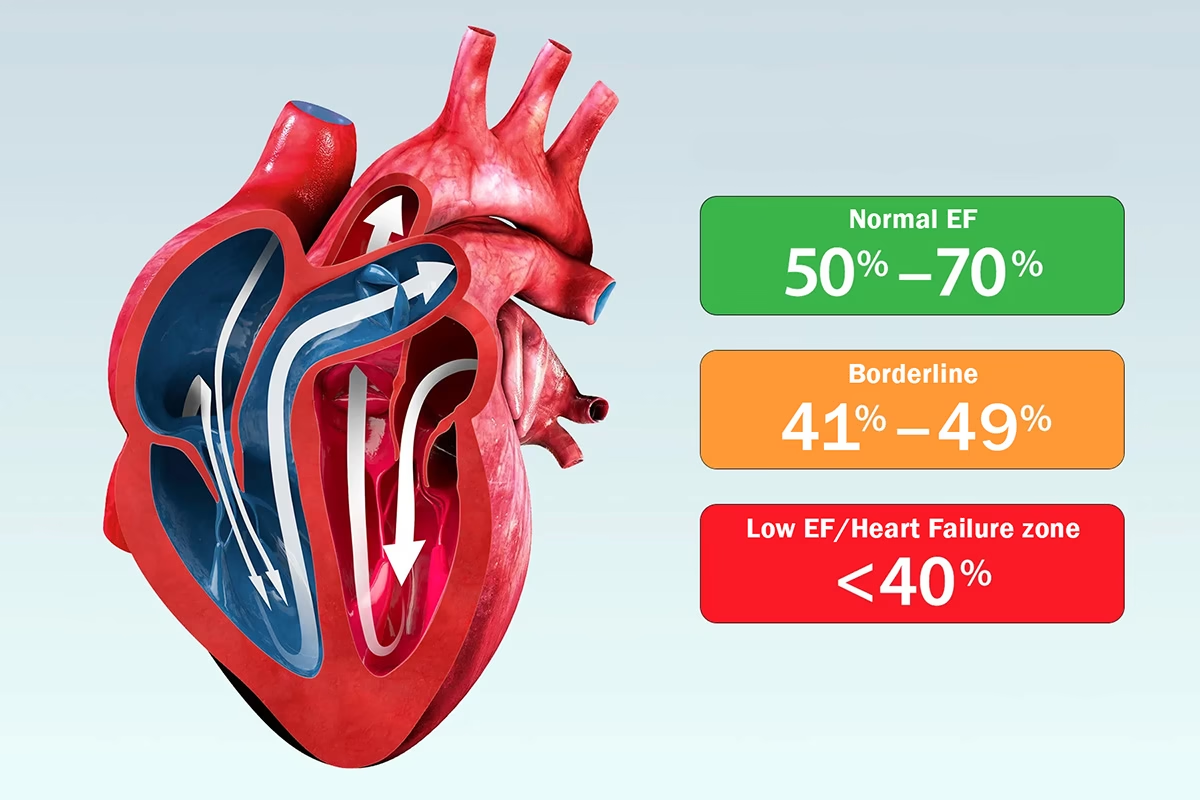Let me guess. You just received your echo report. In a sea of medical terminology, you saw a paragraph like: “Ejection Fraction: 45%.” “If it’s a normal EF range?” or not ?” And now your heart is racing because you are worrying. If you are reading this, you probably want to know what your doctor has just told you, or perhaps what they did not. Whether you’re being treated at SAAOL Heartcare Delhi, under the guidance of Dr. Bimal Chhajer, or you’re searching for a non-invasive heart treatment, maybe even considering an alternative to bypass surgery, you’ve come to the right place. And no, you’re not alone. Low EF, weakened heart, needs surgery, these are the things thousands of people get told every year, which can be as bad as the disease.
But here’s the thing:
Ejection Fraction (EF) is not your destiny. It’s just a number. And numbers can change.
Here’s a gentle yet powerful look into what Ejection Fraction truly is, what the normal EF range is, what it’s not, and why (if you’re with the right team) you might not need surgery after all. Not even a single stitch.
Table of Contents
ToggleWhat Is Ejection Fraction (EF)?

Imagine your heart as a smart, muscular pump. Every time it beats, it squeezes out blood to supply oxygen to every corner of your body—your brain, your muscles, even your kidneys. Now, here’s where Ejection Fraction (EF) comes into play: Ejection Fraction is the amount of blood your heart pumps out of its main chamber (the left ventricle) with each beat.
If your heart fills with, for instance, 100 ml of blood and pumps out 60 ml, your ejection fraction (EF) is 60 percent. Simple? Yes.
What is the “Normal” Ejection Fraction Range?

You’ve probably heard most doctors say this:
Normal EF: 50–70%
Borderline: 41–49%
Low EF / Heart Failure zone: 40% or below
And that is technically true, but it is not the whole story.
You see, EF is not your heart’s only performance measure. A lot of patients are running around with something like a 30% EF, and living a full, meaningful, active life, but without undergoing surgery. Others will have only 55% EF, but still feel tired, out of breath, and with chest pain. So, don’t let the “number trap” befall you. EF only tells you how much blood is being pumped — not necessarily how well you feel.
Why EF Isn’t Everything – And What Else You Need to Know about It
Let’s bust a myth right here:
“An increased EF consistently means a healthier heart.”
Nope. Not true.
Here’s something that most websites and even doctors don’t discuss:
Preserved EF Heart Failure (HFpEF)
It is possible to have a normal EF range (55–65%) and have symptoms of heart failure. Why? It’s because the muscle around your heart is constricted. It can still eject blood (maintained EF), but it can’t fill. So total blood flow drops, along with your energy.
This is known as Heart Failure with Preserved Ejection Fraction (HFpEF) — a condition that’s particularly prevalent in:
- Women over 60
- Individuals with hypertension
- Diabetics
- Individuals with obesity or metabolic syndrome
You may have “good EF” on paper, but if your heart is stiff or inflamed, your quality of life may remain poor. And then there’s the opposite scenario…
When a Low EF Isn’t the End of the World
Many individuals diagnosed with low EF — let’s say 30%, even 20% — are informed that they “should have surgery,” that their heart is “failing.” But does that hold up across the board?
Not always.
And in reality, several patients from SAAOL Heartcare Delhi of Dr. Bimal Chhajer have been treated for a low EF without the bypass surgery and angioplasty.
Here’s how:
- EECP treatment in Delhi/NCR, which is a non-surgical heart treatment to improve blood flow by the technique of heart pumping naturally
- Lifestyle Modifications (diet, stress)
- Optimal medication
- Yoga and Detox treatments
- Finally, and most importantly: time + patience
The heart is capable of remodeling. And a “weak” heart muscle can regain strength with the right inputs. EF can get better — even double — in some patients.
The Surprising Science Behind EF
The brain-heart link:
When you are under ongoing stress, your nervous system remains in “fight or flight” mode. This raises heart rate, tightens vessels, and elevates blood pressure — all of which make the heart’s job harder. This “wear and tear” of the heart muscle over time contributes to a decline in EF. Reversing stress isn’t just spiritual advice—it’s cardiac rehabilitation.
Inflammation and EF:
Chronic inflammation (from processed food, pollution, sugar, and infections) can silently injure your heart cells. This results in myocardial fibrosis: stiffening and scarring of the walls of the heart.
Medications matter—but so does when and how you use them:
A 10–20% increase in EF at 6 months has been observed in some patients on optimal doses of ACE inhibitors, beta-blockers, and MRAs. But medicines work better when supported by lifestyle changes—something traditional cardiology often overlooks.
How EECP Can Increase Ejection Fraction—Without Surgery
EECP therapy (Enhanced External Counter Pulsation) is frequently described as “a safer alternative to bypass surgery,” but it’s closer to the mainstream than you might think.
EECP is FDA-approved and practiced worldwide as a safe, non-invasive method to stimulate blood flow and improve heart function.
- You lie down on a comfortable bed
- Cuffs are placed on your legs
- These cuffs rhythmically squeeze and relax with your heartbeat
- This pushes blood back to the heart, improving oxygenation
Over multiple sessions, this:
- Builds natural bypasses in the heart
- Reduces angina symptoms
- Can increase EF in suitable patients by 5–10%, sometimes more
- Avoids the trauma of cutting, anesthesia, or stents
At SAAOL Heartcare Delhi, you get the best EECP treatment in Delhi/NCR, as 6 lakh+ patients have trusted it as a safer alternative method to bypass surgery.
Can EF Be Reversed Naturally?
Patients are, in most cases, asking this question. And here’s the honest, science-based answer:
Yes, EF can be improved.
No, it’s not going to happen overnight.
Yet with the right lifestyle, treatments, and mindset, the heart can regenerate its lost beat.
A few underrated natural EF boosters:
- Nitrate-rich foods: beetroot, pomegranate, spinach
- CoQ10 and L-carnitine (natural supplements that power heart mitochondria)
- Mindful walking and slow breathing
- Warm water therapy
- Time-restricted eating (gives heart cells recovery time.
When to Worry About Your EF—And When Not to
Things to worry about for EF:
- It’s consistently <35%
- You have been short of breath lately
- Your legs are swollen
- You feel dizzy even at rest
- You’ve passed out or had an irregular heartbeat.
But you shouldn’t panic if:
- You have no symptoms
- Your EF is improving gradually
- Your lifestyle is aligned with healing
- You’re under the care of an expert team (like Dr. Bimal Chhajer and the SAAOL Heartcare Delhi)
Let’s Discuss You — Yes, You
If you’re here, you’re likely worried. Perhaps a loved one got a low EF diagnosis. Or perhaps you want to steer clear of bypass surgery. Perhaps you simply wish to reverse heart disease without surgery, and are here for a new strategy.
Here’s what I want to tell you as someone who’s seen thousands of patients walk in terrified and walk out empowered:
Your EF is not a life sentence.
It is a signal—a call to listen, to change, and to heal.
And you are much more powerful than you realize.
It’s a world where people are terrorized into surgeries. Where a low EF is a death knell. But the truth is that you are a person who has options, who has hope, who can heal. And in places like SAAOL Heartcare Delhi, under the guidance of Dr. Bimal Chhajer, a different form of cardiology is quietly taking hold —one that believes in treating the root, not just the result.
If your EF is low or you want to know your normal EF range, don’t lose your sleep. Ask better questions, instead:
Why did it drop?
Can it be improved?
What is my role in improving it? Because when your heart speaks, it’s never only about biology — it’s about your life.
Ready to Move to the Next Level?
Whether you are searching for EECP in Delhi/NCR, trying to prevent bypass surgery, or interested in a non-surgical heart disease treatment, the solutions—and the cure—may be closer than you think.
Visit SAAOL Heartcare Delhi. Consult with experts who treat you as a human being rather than as a number.
In other words: Whatever you do, in particular, don’t lose your heart.


